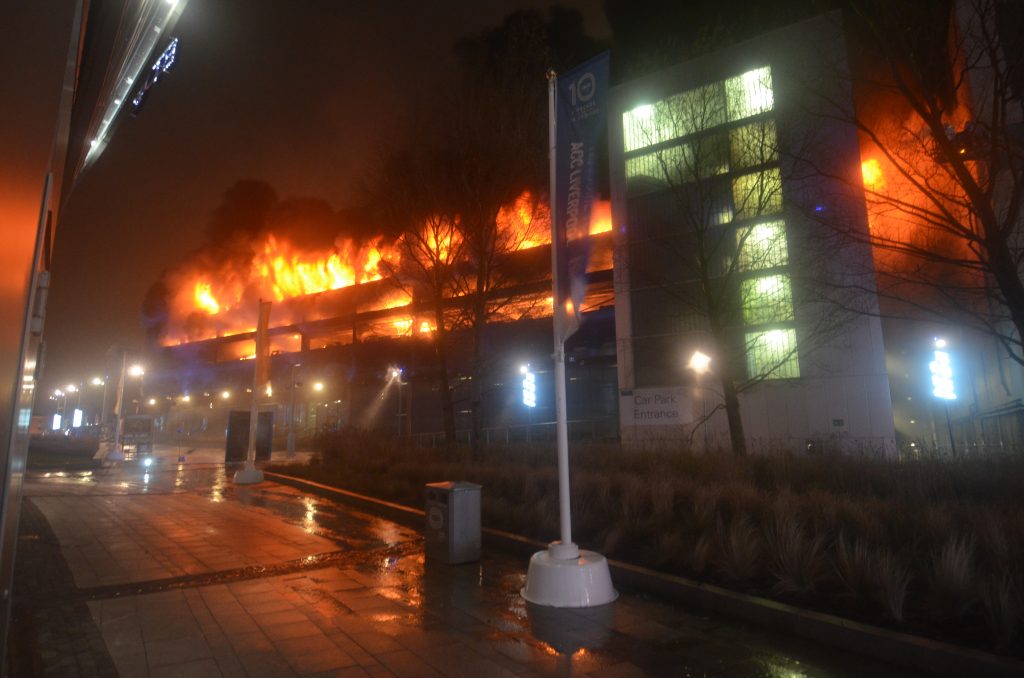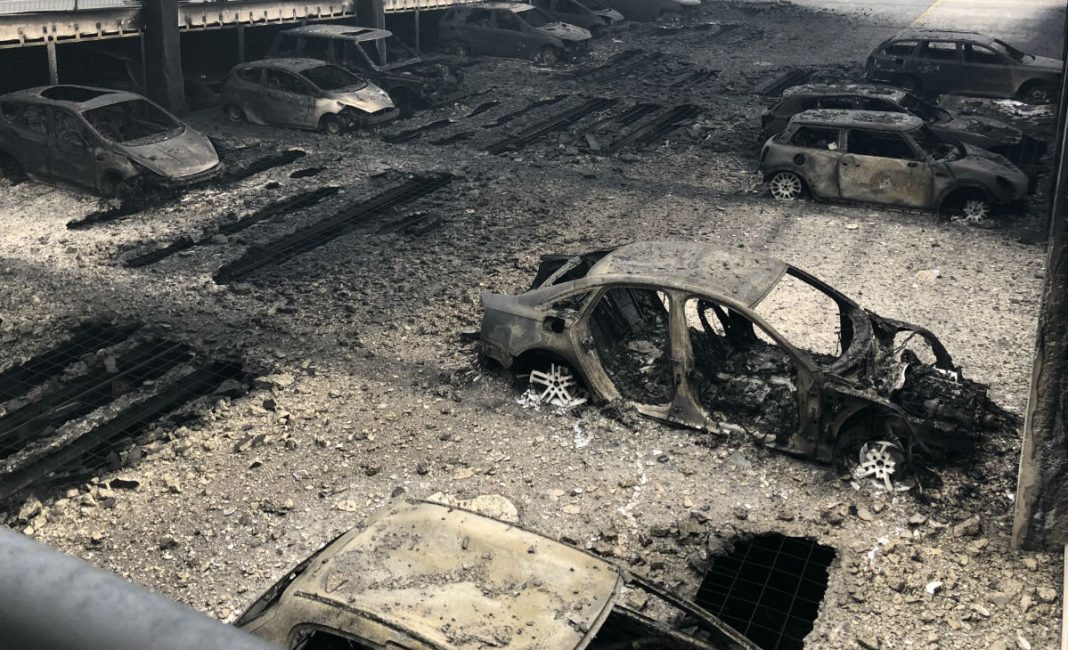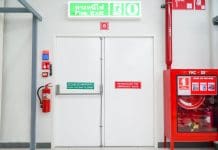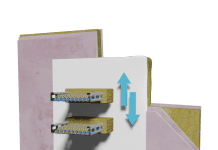After the devastating fire in the Echo Arena car park, Ian Gough of BAFSA says the warning signs were clear – and highlights the hard evidence that sprinkler systems can significantly reduce the damage and danger caused by such incidents
The fire at the Echo Arena car park in Liverpool on New Year’s Eve came as a shock to many – building experts and members of the public alike. Fortunately, despite the loss of some 1,400 vehicles and insurance claims currently being estimated to be in excess of £20m, no one was injured by the fire and so public outrage is, understandably, far more muted than that expressed nationally post the Grenfell Tower disaster.
Nevertheless, the fire has prompted many motorists to question the safety of large multi-storey car parks and the Mayor of Liverpool, Joe Anderson, has written to Nick Hurd MP, the minister responsible for policing and the Fire Service, questioning “whether existing regulations are fit for purpose, given that modern cars contain more flammable parts than they did previously”.
The minister’s reply will make for interesting reading. However, many within the fire sector have been fearful that it was only a matter of time before the UK experienced a devastating fire in a car park, as warning signs have increasingly been appearing for anyone to see. Frustratingly, it seems, those warning signs have gone unheeded.
Warning signs
In recent years, a number of very serious fires have occurred in car parks and deaths have occurred. Indeed, just before Christmas 2017 in South Korea, a fire spread from a car parked in an underground parking area to engulf an eight-storey building above, killing 29 people and injuring dozens of others. Closer to home, at the time of writing we learned of a fire in a car park in France that sadly claimed the life of a young firefighter.
On 10 January, at Choisy-le-Roi, a commune in the south-east suburbs of Paris, 200 residents were evacuated from apartments above a car park due to a fire thought to have been started deliberately. While conducting firefighting operations, Sergeant Jonathan Lassus-David, a 28-year-old firefighter and father of two, was injured and subsequently died in hospital four days later.
But the dangers posed to firefighters tackling fires in parked cars are not something new.
In November 2004, a fire started in a car left in a below ground car park which was part of an apartment complex in Gretzenbach, a village about 40 kilometres (25 miles) west of Zurich. During firefighting operations, the ceiling collapsed and seven firefighters lost their lives.
In October 2006, Dutch firefighters wisely chose not to enter a blazing car park in Haarlem when fire erupted on the lower of two underground levels of the Appelaar garage and destroyed at least 26 cars. In view of the smoke and heat, officers chose to simply fill the lower level of the garage with water.
Subsequently, this fire led to questions in the Dutch parliament as not only did smoke from the garage enter the courthouse and concert theatre above, making both unusable, but also the structure of the car park was so damaged by the heat that, fearing collapse, additional temporary supports had to be fitted.
Again, in March 2010, below the Ritz Hotel in Paris, a similar fire occurred when over 30 cars were destroyed, two people were taken to hospital suffering from smoke inhalation and the famous Place Vendome was evacuated.
A common factor in each of these examples is that below ground car parks are particularly hazardous – especially to firefighters.
Fires in the open air
Ever since motor cars first started to appear in our towns and cities in large numbers and covered parking areas were provided, ventilation has always been seen as a primary safety factor – mainly because of the risks posed by vehicle exhaust fumes and also the dangers from any spillages of petrol. Increasingly, however, the dangers of fire spreading from one vehicle to another were thought to be reduced if adequate mechanical or natural ventilation was provided.
However, if we think that a lack of adequate ventilation (and the presence of a ceiling providing a barrier to stop heat from escaping) could be a key to the current problem, we might want to think again considering the serious fires that have occurred in the open air.
- In 2008, 19 cars parked in a field were destroyed in a fire at the Reading Festival.
- In August 2010, at Stanstead Airport, a fire in an open air parking lot destroyed 24 vehicles.
Worryingly, in each case, a single car fire spread to other vehicles parked nearby, creating large conflagrations. Surely, if fire can spread in an open air car park, how much ventilation would you need to prevent fire spread in an enclosed parking space?
New hazards
Of particular concern is the fact that the average family cars of today, including growing numbers of Sports Utility Vehicles and people carriers, have significant percentages of plastics and other combustibles in their construction.
Added to this are worries about the growing demands for ‘alternative fuels’ such as Liquefied Petroleum Gas (LPG) and hydrogen. These fuels are not only explosive (as is petrol) but, compared to traditional fuels, there is very little known about how they might perform when involved in a real vehicle fire – especially in an enclosed space such as an underground car park.
In short, modern cars can burn very quickly, producing much larger and hotter fires than was previously considered possible. Indeed, until recently, it was assumed to be unlikely that a fire could spread from one parked car to another. However, this can no longer be relied on to be the case as evidence from real fires – especially those in the open air – clearly contradicts this assumption.
Furthermore, while UK fire statistics have over the years revealed few reported injuries and deaths as a result of fires in car parks, increasing numbers of injuries appear to be as a result of fires in car parks associated with residential accommodation (flats and apartments); and current figures reveal 6.5 times more injuries (per thousand fires) than fires in purpose-built car parks.
 Monica Wills House, Bristol
Monica Wills House, Bristol
Here in the UK, in December 2006, a fire occurred at a newly constructed residential care home with underground car parking in Bristol. In accordance with guidance published in support of building regulations (Approved Document B), the ‘residential’ part of the care home was sprinklered – but the car park was not. Fire destroyed 22 cars and spread to upper levels via external windows, where one person died as a result of smoke inhalation – 60 residents were evacuated. A residential sprinkler system prevented the spread of fire into the residential area and, no doubt, saved many more lives.
This fire prompted questions to be asked by those responsible for building standards and official government guidance.
Building regulations
Guidance on the fire precautions considered necessary in the design and construction of car parks can be found in the Approved Document B to the Building Regulations for England and Wales (ADB) and Scottish Technical Standards. This guidance currently does not require sprinklers to be installed in car parks*. Instead, reliance is placed upon ‘passive protection’ such as fire walls and doors, and smoke ventilation – either natural or mechanical systems. However, this guidance was written in the knowledge of fire tests carried out in the 1960s and on cars that are very different from those manufactured today.
This lack of up-to-date knowledge has led to worries that current UK building standards are no longer entirely appropriate for modern day car park risks – particularly where innovative mechanical parking systems are being installed, such as ‘car stackers’.
Government concerns
In 2006, the Communities & Local Government (CLG) Sustainable Buildings Division commissioned the Building Research Establishment (BRE Global) to carry out a three-year project looking at the problems associated with fires in car parks. The research provides valuable information for designers and other building professionals about the hazards and risks associated with modern motor cars.
Along with a review of current relevant literature, fire statistics, computer modelling and studies of the fire behaviour of materials commonly used in car manufacture, the project team also carried out a number of realistic fire tests including:
- Experimental study – fire spread between cars.
- Experimental study – LPG-fuelled vehicles.
- Car stacker test.
Experimental study
A test rig was constructed, measuring 6m x 12m, with space for four cars but leaving one vacant parking space. The structure was enclosed at high level but with low level ventilation. In all, three tests were conducted in this rig.
In the first test, without sprinklers and with small to medium-sized family cars, fire spread from the car of origin (Car 1) to involve all three vehicles. It took 20 minutes to involve Car 2; however, only 21 minutes from ignition to involve Car 3 when the test was terminated to avoid serious damage to monitoring equipment. Nevertheless, with the data gathered revealing a ‘peak heat release rate’ of 16 megawatts, this test clearly revealed the ability of this type of fire to spread to other vehicles and damage buildings.
Similarly, in the third test using medium to large vehicles, the fire spread to all three cars, taking just nine minutes to involve Car 2 and a further minute to involve Car 3. Once again, because of the rapid fire spread, the test was terminated early, thus avoiding costly damage to the calorimeter.
However, in test number two, again with a similar arrangement to tests one and three, the opportunity was taken to install a sprinkler system and observe the results. The rig was provided with a sprinkler system designed as closely as possible to replicate a typical underground car park sprinkler system, to BSEN 12845:2004 ‘Ordinary Hazard 2’. From the time of ignition, the first sprinkler head operated after four minutes and subsequently all heads within the rig operated; but in this case, the fire did not spread to either Car 2 or Car 3. The test was terminated after one hour of the fire dying down.
This research clearly indicates therefore that the provision of automatic fire sprinklers can confine an outbreak of fire to the vehicle of origin – and thus allow safe entry for firefighters to fully extinguish any remnants of a fire.
Finally, a quite separate experiment was carried out involving a basic car stacking system, without any fixed suppression, in the main Burn Hall at the Building Research Establishment. This test again revealed the high probability of rapid fire spread leading to full involvement of the fire compartment and commensurate high levels of risks to any attending firefighters.
Established track record: Sprinklers 99% successful
Fire sprinkler systems have been protecting lives and property for over 100 years and, since the development of the motor car, sprinklers have protected many of our city centre car parks successfully with minimum fuss. Indeed, between 1994 and 2005, there were 3,095 reported fires in car parks in the UK:
- Of these, only 162 fires occurred where a fixed fire suppression system was present.
- Automatic fire sprinklers extinguished or contained 100 of these fires.
- In only 1% of cases, fire sprinklers operated but did not extinguish or contain the fire and it is, therefore, to be assumed that the remainder were too small to actuate the sprinklers and either simply burned out or were extinguished quickly by persons using fire extinguishers etc.
Source: UK Fire Statistics
Conclusion
The response to the ‘warning signs’ back in 2006 about fires in car parks from the government was admirable and the work carried out by the BRE was excellent; its report is still as valid today as it was when published. However, there is little evidence that anything other than scant attention has been paid to this research and this is worrying.
In her Independent Review of Building Regulations and Fire Safety, produced as a result of the Grenfell Tower fire, Dame Judith Hackitt is critical of the culture that exists within the construction industry and states: “There is a widespread culture in relation to building and fire standards of waiting to be told what to do by regulators rather than taking responsibility for building to correct standards. The approach is very much driven by aiming for minimum compliance, not ensuring safety for the lifetime of the building.”
The evidence relating to real fires and the apparent lack of investment by developers in improved standards of fire protection in new car parks – especially in the provision of automatic fire sprinkler systems – is perhaps yet another example of this culture of failing to act before being told to by regulators.
Merseyside’s Chief Fire Officer Dan Stephens said after the Arena fire that: “One thing is for certain – had the building been sprinklered, there is every chance that would have suppressed the fire sufficiently then for us to be able to go in and extinguish the fire without it spreading in the way that it did.”
Those responsible for the construction and management of car parks would be wise to take note of the Chief Fire Officer’s words. The evidence is clearly available to back up his claims.
*Note: for buildings located within the inner London area, the requirements of the London Building Act 1939 Section 20 apply, which might require sprinklers in certain car parks e.g. enclosed or basement car parks.
Fire Sprinkler 2018, the only conference in the UK focusing on automatic fire sprinklers, takes place at the Marriott Forest of Arden on 14 November 2018.
Ian Gough C.Build E MCABE MIFireE
Technical Adviser
BAFSA
Twitter: @BAFSAfocus










![[VIDEO]What to expect when you’re inspecting: Using DorTrak for fire door inspections](https://www.pbctoday.co.uk/news/wp-content/uploads/2025/02/maxresdefault-218x150.jpg)



